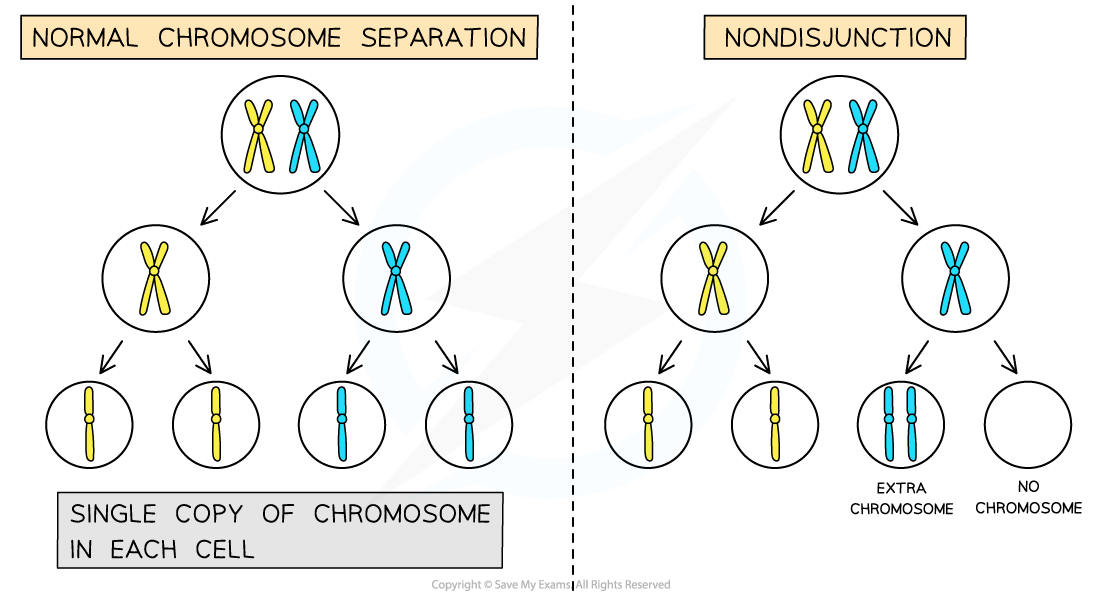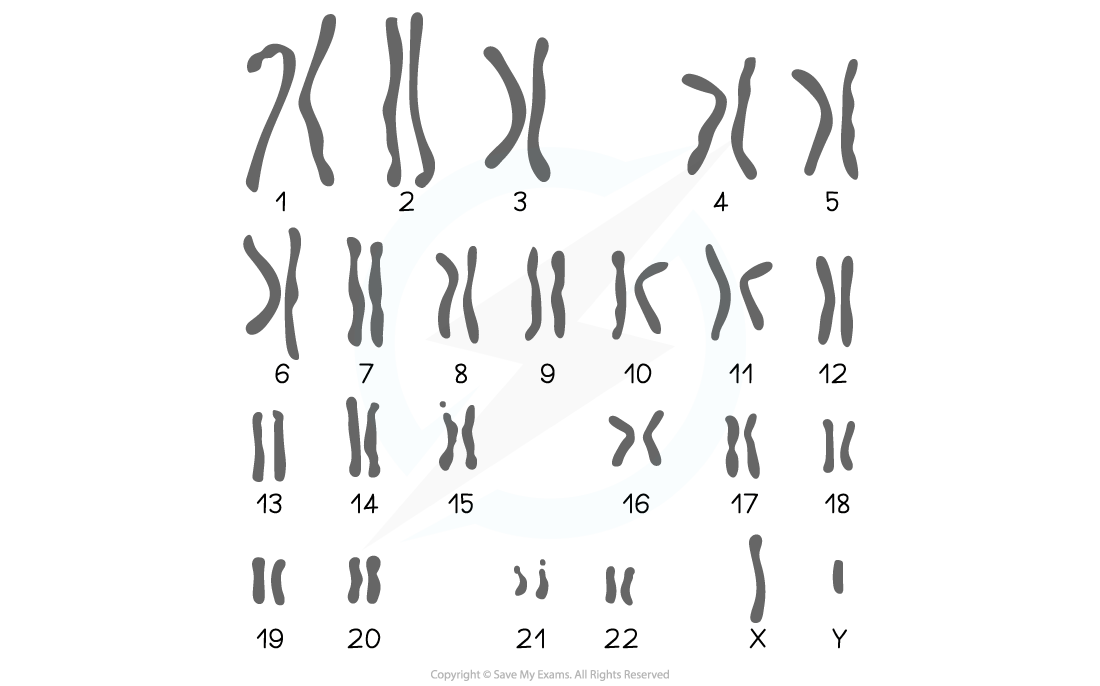Non-disjunction
- Non-disjunction occurs when chromosomes fail to separate correctly during meiosis
- This can occur in either anaphase I or anaphase II, leading to gametes forming with an abnormal number of chromosomes
- The gametes may end up with one extra copy of a particular chromosome or no copies of a particular chromosome
- These gametes will have a different number of chromosomes compared to the normal haploid number
- If the abnormal gametes are fertilized, then a chromosome abnormality occurs as the diploid cell (zygote) will have the incorrect number of chromosomes

Image showing how chromosomes failing to separate properly during meiosis can result in gametes with the incorrect number of chromosomes
Down Syndrome
- A key example of a non-disjunction chromosome abnormality is Down syndrome, also called Trisomy 21
- Non-disjunction occurs during anaphase I (in this case) and the 21st pair of homologous chromosomes fail to separate
- Individuals with this syndrome have a total of 47 chromosomes in their cells as they have three copies of chromosome 21
- The impact of trisomy 21 can vary between individuals, but some common features of the syndrome are physical growth delays and reduced intellectual ability. Individuals can also suffer from issues with sight or hearing
Other trisomy syndromes
- There are other trisomy possibilities that can result from non-disjunction; many, but not all, have very serious impacts on the phenotype of the offspring which may be fatal
- Patau syndrome (trisomy 13) and Edwards syndrome (trisomy 18) are very serious syndromes which result in many physical disabilities and developmental difficulties
- Trisomy 18 and 13 both have very low survival rates with few babies surviving past their first birthday
- Klinefelter's syndrome is caused by non-disjunction in sex chromosomes which leads to having the chromosomes XXY
- This syndrome is often not diagnosed until adulthood and doesn't impact life expectancy but may have a negative effect on fertility
- Turners syndrome also affects the sex chromosomes with individuals possessing just one X chromosome
- Individuals with Turners syndrome would not necessarily have a reduced life-expectancy, although will often be shorter and may suffer some symptoms such as lack of sexual development during puberty
- Patau syndrome (trisomy 13) and Edwards syndrome (trisomy 18) are very serious syndromes which result in many physical disabilities and developmental difficulties
Age & Non-disjunction
- Many studies have shown that there is a correlation between age and the incidence of non-disjunction
- It is believed that as the age of the parents increases the incidence of non-disjunction increases
- In particular, the age of the mother has been found to increase the chance of having a child with Down Syndrome
- The impact of age on the risks is represented in the table below
Age and Risk of Down’s Syndrome Table

Methods used for Karyotype Analysis
Methods can be used to obtain cells for karyotype analysis
- A karyotype can be created to show an image of all of the chromosomes of an individual from a single cell.
- Chromosomes are arranged into their homologous pairs and studied to check for any abnormalities

This karyogram shows a typical or “normal” karyotype
- A karyotype which shows a chromosomal abnormality may have incorrect numbers of chromosomes present
- Trisomy syndromes will show a third chromosome present at one of the chromosome positions
- For example, Down's syndrome shows a third chromosomes at the 21st position

A karyogram showing the karyotype of an individual with Down’s Syndrome
- Two methods can be used to obtain cells from an unborn child for chromosome testing:
- Amniocentesis
- Chorionic villus sampling
Amniocentesis
- A needle is inserted through the mother's abdomen wall and a small sample of amniotic fluid is taken. The sample will contain some foetal cells for analysis
- This procedure usually takes place around 16 weeks of pregnancy
- There is a small risk of miscarriage associated with the procedure (approx 1%)
- The procedure also poses a small risk of infection
Chorionic Villus Sampling (CVS)
- A long tube is inserted through the vagina and then cervix in order to take a small sample of the developing chorion (a membrane surrounding the embryo which forms part of the placenta)
- This procedure can be carried out earlier in the pregnancy; around 10 - 12 weeks
- CVS has a slightly increased risk of miscarriage associated with the procedure (approx 2%)
- There is also a small risk of infection
